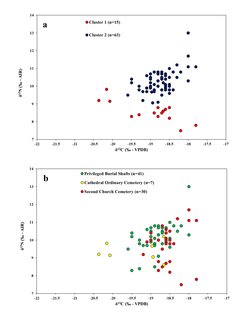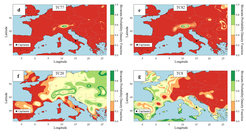Research Confirms Socioeconomic Hierarchies, Elite Mobility in Late Medieval Southern Italy
A high-resolution Bayesian multi‑proxy approach validates the conventional image of a multi-cultural hierarchical society in late medieval Capitanata, southern Italy.

The medieval period played a pivotal role in constructing modern Italian history and culture. Written sources have typically depicted medieval southern Italy as a strongly hierarchical feudal society sustained by an intensive farming economy. However, this overview is the reflection of a historical perspective produced by and for the elite populations of these societies. Now, a new interdisciplinary study led by researchers from the Max Planck Institute of Geoanthropology, in collaboration with other German and Italian institutions, aims to verify this narrative for late medieval (c. 1000-1500 CE) Capitanata, a region in southern Italy. This research combines historical and archaeological evidence with Bayesian modelling of multi-isotope data from human and faunal skeletal remains to inform on the socioeconomic organisation, cultural practices, and demographics of medieval communities from the sites of Tertiveri, Montecorvino, and San Lorenzo in Carminiano.

The research team found that the traditional image of a farming economy that supported a hierarchical society is not far from reality. At the site of Tertiveri, stable carbon (δ13C) and nitrogen (δ15N) isotopic measurements of bone collagen reveal two main dietary clusters with links to social status. Additionally, moderate marine fish consumption by the elites indicates intra-regional trade networks that connected the Adriatic coast to the sub-Apennine area.
Overall, the study suggests that the main subsistence economy of late medieval Capitanata was based on intensive cereal production (mainly wheat and barley, with some minor presence of millet and sorghum) and animal management practices such as pig husbandry and the herding of cattle, sheep and goats. The intensity of these practices is not found in other contemporary sites in the region and is likely associated with demographic growth following the 11th century Norman conquest of southern Italy.
The study also reveals a high level of mobility among the elite classes, offering insights on the multicultural dynamism of late medieval southern Italy. Using stable oxygen isotope (δ18O) results from bone bioapatite, mobile individuals were detected. Then, Bayesian modelling was employed to identify potential places of origins for these individuals. Analysis revealed the presence of likely German aristocrats that may have been associated with the court of Frederik II Hohenstaufen, King of Sicily and Holy Roman Emperor, as well as individuals likely linked with Angevin soldiers who migrated from Alpine regions during the thirteenth century. Interestingly, Tertiveri was ruled by a Muslim knight between 1296-1300 and an individual found in the site, buried according to an Islamic rite, was shown to have travelled from other western Mediterranean coastal regions (e.g. Sicily).

The multi-isotope Bayesian approach employed in this study has largely corroborated the traditional view of a feudal society, but it also adds a high-resolution reconstruction of the socioeconomic, cultural, and demographic dynamics of late medieval southern Italian communities. The legacy of these dynamics is still evident in the linguistic, religious, culinary, and genetic heritage of modern southern Italy.
The authors have identified future research avenues that could further increase the knowledge presented in this study. In particular, radiocarbon dating and Bayesian chronological modelling could allow for a more precise chronology, which in turn could offer a more detailed understanding of trends in socio-economic strategies and links to changing political regimes in Capitanata. Additionally, further refinement of food isotopic values through direct analysis of archaeological materials could potentially lead to more precise Bayesian dietary estimates.


